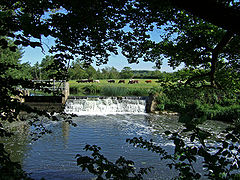Yeovilton
| Yeovilton | |
|---|---|
 Weir on the River Yeo at Yeovilton | |
| Population | 1,226 (2011)[1] |
| OS grid reference | ST545229 |
| District | |
| Shire county | |
| Region | |
| Country | England |
| Sovereign state | United Kingdom |
| Post town | YEOVIL |
| Postcode district | BA22 8 |
| Dialling code | 01935 |
| Police | Avon and Somerset |
| Fire | Devon and Somerset |
| Ambulance | South Western |
| UK Parliament | |
Yeovilton /ˈjoʊv[invalid input: 'ɨ']ltən/ is a village and civil parish in Somerset, England, situated 1 mile (1.6 km) east of Ilchester, 5 miles (8.0 km) north of Yeovil, in the South Somerset district. The village has a population of 1,226.[1]
The parish includes the village of Podimore (also known as or Puddimore or Milton Podimore) and the hamlets of Speckington and Bridgehampton.
The village is home to the RNAS Yeovilton (HMS Heron) and the associated Fleet Air Arm Museum.
History
Yeovilton is close to the route of the Fosse Way a Roman road that linked Exeter (Isca Dumnoniorum) in South West England to Lincoln (Lindum Colonia) in the East Midlands, via Ilchester (Lindinis), Bath (Aquae Sulis), Cirencester (Corinium) and Leicester (Ratae Corieltauvorum). There is evidence of a Romano-British farmstead under what is now the airfield.[2]
Between 899 and 925 an estate in Yeovilton was granted by King Edward and between 955 and 959 King Eadwig gave a further holding of five hides to Brihtric. The parish Yeovilton was part of the hundred of Somerton, while Podimore was part of the Whitley Hundred.[3]
In 1411 the lord of the manor was John Rogers, who also held the manor of Barwick, and by 1602 these had been inherited by Henry Lyte. The holding was purchased by G. D. W. Digby of Sherborne Castle in Dorset in 1857, and remained with the Digby family until 1919.[4]
The village was host to a stage start of the Tour of Britain in 2007.
Since 1993 the Fleet Air Arm’s Memorial Church has been the Church of St Bartholomew in Yeovilton.
Governance
The parish council has responsibility for local issues, including setting an annual precept (local rate) to cover the council’s operating costs and producing annual accounts for public scrutiny. The parish council evaluates local planning applications and works with the local police, district council officers, and neighbourhood watch groups on matters of crime, security, and traffic. The parish council's role also includes initiating projects for the maintenance and repair of parish facilities, as well as consulting with the district council on the maintenance, repair, and improvement of highways, drainage, footpaths, public transport, and street cleaning. Conservation matters (including trees and listed buildings) and environmental issues are also the responsibility of the council.
The village falls within the Non-metropolitan district of South Somerset, which was formed on 1 April 1974 under the Local Government Act 1972, having previously been part of Yeovil Rural District.[5] The district council is responsible for local planning and building control, local roads, council housing, environmental health, markets and fairs, refuse collection and recycling, cemeteries and crematoria, leisure services, parks, and tourism.
Somerset County Council is responsible for running the largest and most expensive local services such as education, social services, libraries, main roads, public transport, policing and fire services, trading standards, waste disposal and strategic planning.
It is also part of the Yeovil county constituency represented in the House of Commons of the Parliament of the United Kingdom. It elects one Member of Parliament (MP) by the first past the post system of election, and part of the South West England constituency of the European Parliament which elects seven MEPs using the d'Hondt method of party-list proportional representation.
Geography and Climate
It lies on the north bank of the River Yeo, from which it gets its name, opposite Limington.
The parish is largely flat, lying mostly between 50 feet (15.2 m) and 75 feet (22.9 m) above sea level, on the alluvium of the Yeo and Cam valleys and partly on clay loam on the Lower Lias.
Below are the average maximum and minimum temperatures, average rainfall, rain days and sunshine recorded between 1981 and 2010 at the Met Office weather station in Yeovilton.
Transport
The village lies south of the A303 trunk road which runs between Basingstoke in Hampshire and Honiton in Devon.
Religious sites
At Podimore the Church of Saint Peter dates from the 14th century and has been designated by English Heritage as a grade I listed building.[6]
The Church of St Bartholomew in Yeovilton dates from around 1300 century and is a grade II* listed building.[7] From 1642 Richard Sterne held the rectory of Yeovilton before going on to become Archbishop of York. The rector between 1762 and 1805 was Daniel Dumaresq after his period as an educational consultant to Russian and Polish monarchs. Since 1993 the church has been owned by the Royal Navy, and it serves as the Memorial chapel for the Fleet Air Arm.
References
- ^ a b "Statistics for Wards, LSOAs and Parishes — SUMMARY Profiles" (Excel). Somerset Intelligence. Retrieved 4 January 2014.
- ^ Lovell, Julie (2006). "Excavation of a Romano-British farmstead at RNAS Yeovilton". Somerset Archaeology and Natural History. 149: 7–70.
{{cite journal}}: Cite has empty unknown parameters:|month=and|coauthors=(help) - ^ "Somerset Hundreds". GENUKI. Retrieved 22 October 2011.
- ^ "Yeovilton". Victoria County History. British History Online. Retrieved 27 November 2008.
- ^ "Yeovil RD". A vision of Britain Through Time. University of Portsmouth. Retrieved 4 January 2014.
- ^ "Church of Saint Peter". Images of England. Retrieved 2008-02-08.
- ^ "Saint Bartholomew". Images of England. English Heritage. Retrieved 2008-10-16.
External links
![]() Media related to Yeovilton at Wikimedia Commons
Media related to Yeovilton at Wikimedia Commons

